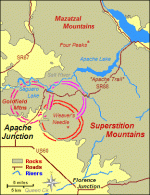deducer
Bronze Member
- Jan 7, 2014
- 2,281
- 4,360
- Primary Interest:
- Other
"matches no known samples in Arizona"
actually that statement is quite ludicrous ...they did not test against the few million possibilities of arizona ore...more than likely they compared it to a few
"Bob Corbin and Tom Kollenborn both swore affidavits stating that they had seen the assay report done by the Goldman's store on the Holmes ore. Neither of them, as far as I'm aware, ever mentioned any trace of silver. "
you have probably never had an assay done but you can request gold only..it cost more to do gold and silver...highly doubtful they would spend extra dough on silver assay
"Considering the proximity of the location of the Pit Mine to claims on file during Waltz's time, isn't it a bit inconceivable that no miners ever came across it?"
maybe the mine was covered back then and couldn't be seen readily
No I have never had an assay done, nor have I and nor will I ever do any mining, or related activity, even as simple as sinking a pick into the ground. The subject of actual mining and geology holds absolutely no interest for me, and my knowledge of either subject is absolutely nil, so anytime I open my mouth about it, I am certain to get in trouble.
Anyway, that being said- I don't think the UA ore collection is anything to sneer at. From the other website:
In the 1920's, 30's, 40's, 50's and 60's, the geology department at the University of Arizona in Tucson was known simply as the, University of Arizona Department of Geology. The Geology department included as one of it's sub departments, the mines and minerology and mineral resources branch. There were some 7 or 8 seperate branches of geological study under the U of A Geology department.
Sometime in the 1970's the U of A at Tucson reorganized their geology department and renamed it the, University of Arizona Geosciences department. There are still some 7 or 8 sub departments of geology at the U of A, the minerology and mineral resources department is just one of them.
Because of the extreme amount of mining done in Arizona, the old Geology department, as well as the newly renamed Geosciences department, focus their studies on structural geology and deposit types and accumulate an enormous collection of ore samples from mines and deposits all over Arizona, focusing on Cu-Mo-Au, epithermal Au-Ag, and iron oxide Cu-Au deposits within Arizona. These deposits make up almost all copper and gold bearing deposits known within Arizona dating back to the 1850's. They have an extensive collection of ore from every known deposit in Arizona that is available.
There is also a three page analysis that was done on the same ore that came from Holmes, the first page of which was posted on the other website. The image is no longer there, but perhaps someone on here has a copy that they could repost?
It states that the Holmes ore (or the ore that it was compared to) comes from the fracture zones of the Tortilla Caldera
The following report is from an analysis done over 40 years ago on some of the exact same ore Dr. Glover EDS tested at the University of Nevada in 1997. Certain parts have had to be blacked out to protect the owner of the gold ore and who contracted to have the analysis done. The resulting analysis of the testing done over 40 years ago concludes the ore tested can be matched to no other known ore deposit anywhere in Arizona.
The Tortilla caldera is the youngest of 4 calderas within the Superstition mountain range. The Superstition caldera being the oldest, collapsed and the Tortilla caldera rose and fell taking over a third of the NE part of the older Superstition caldera with it, altering the geology of the older portion of the Superstition caldera and mixing it with the geology of the newer Tortilla caldera. The other two known calderas in the region, the Doggie Springs and the Black Mesa calderas do not appear to have significantly affected the geology of the Tortilla caldera.
The Superstition Cauldron Complex
Tortilla Caldera in pink:

Last edited:



 ...
...